#the viewer archetype
Explore tagged Tumblr posts
Text
[The] Viewer/Watcher Archetrope

A flag for archetropers whose archetrope is simply a viewer/watcher. Whether it be the viewer as in an audience, the one documenting events, the passing observer, a ceaseless watcher, or an archivist. You are watching. You are viewing. You are listening. You are Seeing.
Those with this archetrope may also feel connected to [Night Vale] Podcaster, Avatar of the Eye, Historian, Archivist, or other similar documenting/observing-relating archetropes.
#flag coining#needs id#alterhuman#archetypes#archetype flag#alterhuman coining#alterhuman flag#alterhumanity#archetrope#archetrope flag#the viewer archetype#the viewer#the viewer archetrope#the watcher#the watcher archetype#the watcher archetrope
14 notes
·
View notes
Text





Micaclan as textposts pt 2, birchspeckle edition (+mudpaw)
pt 1
#rye's art#micaclan#birchspeckle#mudpaw#side note the first screenshot with birch's back to the viewer is like Archetypal birchspeckle shapes to me for some reason#I love her goofy mullet type deal she's got going on
108 notes
·
View notes
Text
so am i right or am i right in my assertion that bridgerton doesn't actually do character work, it just rebrands it's main characters before their season begins and tries to recontextualize them as poor little meow meows.
#olive rambles#watched the first half of season 3#was thinking to myself: huh. pen isn't that bad.#and then decided to rewatch some season 2 scenes to recontextualize who the characters are. y'know. so i can be an intelligent viewer#and all that jazz.#and damn you bridgerton i fell for your trap for a second there.#SHE'S NOT !!!!!!! THE SAME !!!!!!!! CHARACTER !!!!!!!!!#this isn't just about framing a narrative differently season 2 pen and season 3 pen are different girlies entirely#WHERE IS THE WRATH#i *want* a vengeful penelope featherington damnit#even if i don't like her as a person i could respect her as a character#and yet#they just make her a soft sadgirl#which also feels very cheap because women can be angry and messy and vengeful and still find love#honestly get polin out of here and get penelope angry again#i want to see BLOOD or season 2 is cheapened in retrospect#look me in the eye and tell me i'm wrong#you can't#i am the god of this chilis and i have spoken#i think over the summer i'm going to watch all of bridgerton over again so i can make a corkboard of theories#and be intelligent in my hate#PENELOPE WAS ANGRY AND LOUD ABOUT IT IN SEASON 2 AND SOMEHOW SHE IS NOW JUST SAD AND RUMINATING IN SEASON 3#BITCH WHEN AND WHERE DID THIS CHANGE TAKE PLACE AND WHY#AND ALSO FOR WHAT ANGRY ACTIONABLE CHARACTERS ARE DYNAMIC AND HARD TO PREDICT AND MAKE FOR GOOD CINEMA#SAD CHARACTERS THAT SIT AND THINK ABOUT THINGS ARE OKAY TOO BUT THEY ARE NOT !!!!! THE SAME !!!!! AS THE FORMER ARCHETYPE#AND THEY SHOULDN'T BE!!!!!!!!
4 notes
·
View notes
Text

really loving this new archetype of main character this anime season. can't quite put my finger on why i think they're all so cool ...
[ID: a line up of three characters, Laios from Delicious in Dungeon/Dungeon Meshi, Frieren from Frieren: Beyond Journey's End/Sousou no Frieren and MaoMao from Apothecary Diaries/Kusuriya no Hitorigoto. a semi-transparent autism creature is behind the characters, staring at the viewer. End ID]
#delicious in dungeon#dungeon meshi#frieren: beyond journey's end#the apothecary diaries#maomao#yippee
2K notes
·
View notes
Text
Hey so can we like stop with the "Zutara is for the girls and Kataang is for the boys" thing. It's silly and it's breakdancing just on the edge of gender essentialism.
The assumption that there is something inherent to Zutara that appeals predominantly to women and Kataang that appeals predominantly to men is dishonest because every ship can have appeal to all genders.
The discussion of the "female gaze" in Zutara and the "male gaze" in Kataang is also redundant. I enjoy dissecting the concept of "the gaze", however it is important to note that the "female gaze" doesn't have a set definition or grouping of conventions it adheres to. Lisa French, Dean of RMIT University’s School of Media and Communication says:
“The female gaze is not homogeneous, singular or monolithic, and it will necessarily take many forms... The aesthetic approaches, experiences and films of women directors are as diverse as their individual life situations and the cultures in which they live. The "female' gaze” is not intended here'to denote a singular concept. There' are many gazes."
Now excuse me as I put on my pretentious humanistics student hat.
Kataang's appeal to women and the female gaze
Before I start, I want to note that the female gaze is still a developing concept
There are very few female film directors and writers, and most of them are white. The wants and desires of women of colour, the demographic Katara falls into, are still wildly underepresented. Additionally, the concept of the female gaze had many facets, due to it being more focused on emotional connections rather than physical appearance as the male gaze usually is. Which means that multiple male archetypes fall into the category of "for the female gaze".
The "female gaze" can be best described as a response to the "male gaze", which was first introduced by Laura Mulvey in her paper: "Visual Pleasure and Narrative Cinema" , however the term "male gaze" itself was not used in the paper.
Mulvey brought up the concept of the female character and form as the passive, objectified subject to the active voyeuristic male gaze, which the audience is encouraged to identify, usually through the male character.
To quote her:
"In a world ordered by sexual imbalance', pleasure' in looking has been split between active'/male' and passive/female'. The determining male gaze' projects its fantasy onto the female' figure', which is styled accordingly."
Mulvey also brings up the concept of scopopfillia (the term being introduced by Freud), the concept of deriving sexual gratification from both looking and being looked at. This concept has strong overtones of voyeurism, exhibitionism and narcissism, placing forth the idea that these overtones are what keeps the male viewer invested. That he is able to project onto the male character, therefore being also able to possess the passive female love interest.
However, it's important to note that Mulvey's essay is very much a product of its times, focused on the white, heterosexual and cisgender cinema of her time. She also drew a lot of inspiration from Freud's questionable work, including ye ole penis envy. Mulvey's paper was groundbreaking at the time, but we can't ignore how it reinforces the gender binary and of course doesn't touch on the way POC, particularly women of colour are represented in film.
In her paper, Mulvey fails to consider anyone who isn't a white, cis, heterosexual man or woman. With how underrepresented voices of minorities already are both in media and everyday life, this is something that we need to remember and strive to correct.
Additionally Mulvey often falls into gender essentialism, which I previously mentioned at the beginning of this post. Funny how that keeps coming up
"Visual Pleasure and Narrative Cinema" started a very interesting and important conversation, and I will still be drawing from certain parts of it, however huge swathes of this text have already become near archaic, as our culture and relationship with media evolves at an incredible pace.
And as filmaking evolves, so does our definition of the male and female gaze. So let's see what contemporary filmakers say of it.
In 2016, in her speech during the Toronto International Film Festival , producer of the TV series Transparent, Jill Soloway says:
“Numero uno, I think the Female Gaze is a way of “feeling seeing”. It could be thought of as a subjective camera that attempts to get inside the protagonist, especially when the protagonist is not a Chismale. It uses the frame to share and evoke a feeling of being in feeling, rather than seeing – the characters. I take the camera and I say, hey, audience, I’m not just showing you this thing, I want you to really feel with me.
[Chismale is Soloway's nickname for cis males btw]
So the term "female gaze" is a bit of a misnomer, since it aims to focus on capturing the feelings of characters of all genders. It's becoming more of a new way of telling stories in film, rather than a way to cater to what white, cisgender, heterosexual women might find attractive in a man.
Now, Aang is the decided protagonist of the show, however, Atla having somewhat of an ensemble cast leads to the perspective shifting between different characters.
In the first episode of atla, we very much see Katara's perspective of Aang. She sees him trapped in the iceberg, and we immediately see her altruism and headstrong nature. After she frees Aang, we are very much first subjected to Katara's first impressions of him, as we are introduced to his character. We only see a sliver of Aang's perspective of her, Katara being the first thing he sees upon waking up.
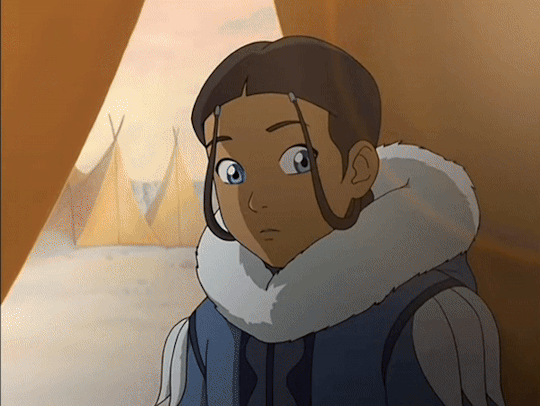
We see that she is intrigued and curious of him, and very excited about his presence. She is endeared and amused by his antics. She is rediscovering her childish side with his help. She is confiding in him about her own trauma surrounding the Fire Nation's genocide of the Southern Waterbenders. She is willing to go against her family and tribe ans leave them behind to go to the Northern Water Tribe with Aang. We also see her determination to save him when he is captured.
As the show moves on and the plot kicks into gear, we do shift more into Aang's perspective. We see his physical attraction to her, and while we don't see Katara's attraction quite as blatantly, there are hints of her interest in his appearance.

This is where we get deeper into the concept of Aang and Katara's mutual interest and attraction for one another. While her perspective is more subtle than most would like, Katara is not purely an object of Aang's desire, no more than he is purely an object of her desire.
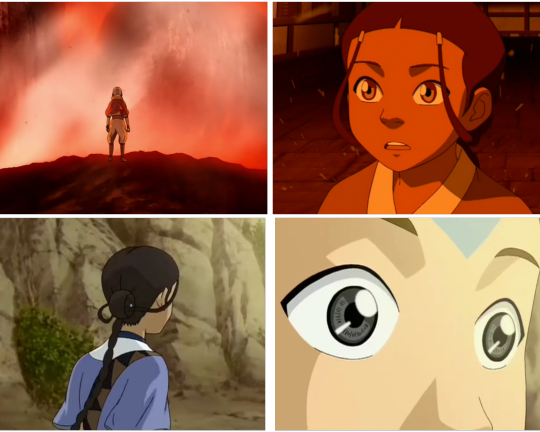
When analysing this aspect of Katara and Aang's relationship, I couldn't help but be reminded of how Célene Sciamma's Portrait of a lady on fire (in my personal opinion, one of the best studies of the female gaze ever created) builds up its romance, and how it places a strong emphasis on the mutuality of the female gaze.
Portrait of a lady on fire's cinematography is very important to the film. We see the world through the perspective of our protagonist, a painter named Marianne. We also see her love interest, Héloïse, the woman whom she is hired to paint a portrait of, through Marianne's lense.
We see Marianne analyse Héloïse's appearance, her beauty. We look purely through Marianne's eyes at Héloïse for a good part of the movie, but then, something unexpected happens. Héloïse looks back. At Marianne, therefore, in some way, also at the audience. While Marianne was studying Héloïse, Héloïse was studying Marianne.
We never shift into Héloïse's perspective, but we see and understand that she is looking back at us. Not only through her words, when she for example comments on Marianne's mannerisms or behaviours, but also hugely through cinematography and acting of the two amazing leads. (Noémie Merlant as Marianne and Adèle Haenel as Héloïse. They truly went above and beyond with their performances.)
This is a huge aspect of the female gaze's implementation in the film. The camera focuses on facial expressions, eyes and body language, seeking to convey the characters' emotions and feelings. There's a focus on intense, longing and reciprocated eye contact (I have dubbed this the Female Gays Gaze.). The characters stand, sit or lay facing each other, and the camera rarely frames one of them as taller than the other, which would cause a sense of power imbalance.
The best way to describe this method of flimaking is wanting the audience to see the characters, rather than to simply look at them. Sciamma wants us to empathise, wants us to feel what they are feeling, rather than view them from a distance. They are to be people, characters, rather than objects.
Avatar, of course, doesn't display the stunning and thoughtful cinematography of Portrait of a Lady on Fire, and Katara and Aang's relationship, while incredibly important, is only a part of the story rather than the focus of it.
However, the 'Kataang moments' we are privy to often follow a similar convention to the ones between Marianne and Héloïse that I mentioned prior.
Theres a lot of shots of Katara and Aang facing each other, close ups on their faces, particularly eyes, as they gaze at one another.
Katara and Aang are often posited as on equal grounds, the camera not framing either of them as much taller and therefore more powerful or important than the other. Aang is actually physically shorter than Katara, which flies in the face in usual conventions of the male fantasy. (I will get to Aang under the male gaze later in this essay)
And even in scenes when Aang is physically shown as above Katara, particularly when he's in the Avatar state, Katara is the one to pull him down, maintaining their relationships as equals.
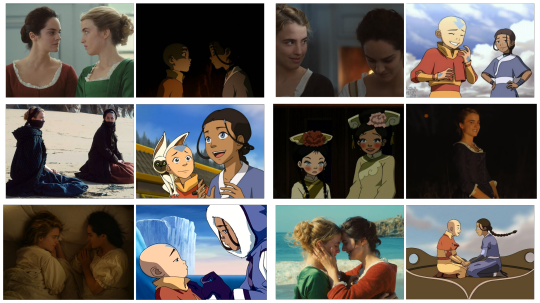
Despite most of the show being portrayed through Aang's eyes, Katara is not a passive object for his gaze, and therefore our gaze, to rest upon. Katara is expressive, and animated. As an audience, we are made aware that Katara has her own perspective. We are invited to take part in it and try to understand it.
Not unlike to Portrait of a Lady on Fire, there is a lot of focus placed on mannerisms and body language, an obvious example being Katara often playing with her hair around Aang, telegraphing a shy or flustered state. We also see her express jealousy over Aang, her face becoming sour, brows furrowed. On one occasion she even blew a raspberry, very clearly showing us, the audience, her displeasure with the idea of Aang getting attention from other girls.
Once again, this proves that Katara is not a passive participant in her own relationship, we are very clealry shown her perspective of Aang. Most of the scenes that hint at her and Aang's focus on their shared emotions, rather than, for example, Katara's beauty.
Even when a scene does highlight her physical appearance, it is not devoid of her own thoughts and emotions. The best example of this being the scene before the party in Ba Sing Se where we see Katara's looking snazzy in her outfit. Aang compliments her and Katara doesn't react passively, we see the unabashed joy light up her face, we can tell what she thinks of Aang's comment.
In fact, the first moment between Katara and Aang sets this tone of mutual gaze almost perfectly. Aang opens his eyes, and looks at Katara. Katara looks back.
There is, once again, huge focus on their eyes in this scene, the movement of Aang's eyelids right before they open draws out attention to that part of his face. When the camera shows us Katara, is zooms in onto her expression as it changes, her blinking also drawing attention to her wide and expressive eyes.

This will not be the first time emphasis is placed on Katara and Aang's mutual gaze during a pivotal moment in the show. Two examples off the top of my head would be the Ends of B2 and B3 respevtively. When Katara brings Aang back to life, paralleling the first time they laid eyes on one another. And at the end of the show, where their gaze has a different meaning behind it.
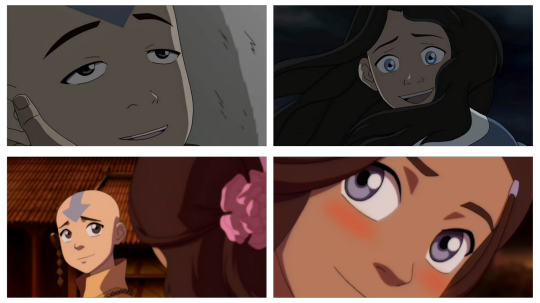
We see Katara's emotions and her intent telegraphed clearly in these instances.
In Book 1, we see her worry for this strange bald boy who fell out of an iceberg, which melts away to relief and a hint of curiosity once she ascertains that he isn't dead.
In B2 we once again see worry, but this time it's more frantic. Her relationship with Aang is much dearer to her heart now, and he is in much worse shape. When we see the relief on her face this time, it manifests in a broad smile, rather than a small grin. We can clearly grasp that her feelings for Aang have evolved.
In B3, we step away from the rule because Aang isn't on the verge of death or unconsciousness for the first time. It is also the first time in a situation like this that Aang isn't seeing Katara from below, but they are on equal footing. I attribute this to symbolising change of pace for their relationship.
The biggest obstacle in the development of Katara and Aang's romance was the war, which endangered both their lives. Due to this, there was a hesitance to start their relationship. In previous scenes that focused this much on Aang and Katara's mutual gaze, Aang was always in a near dead, or at least 'dead adjacent' position. This is is a very harsh reminder that he may very well die in the war, and the reason Katara, who has already endured great loss, is hesitant to allow her love for him to be made... corporeal.
However, now Aang is standing, portraying that the possibily of Katara losing him has been reduced greatly with the coming of peace, the greatest obstacle has been removed, and Katara is the one to initiate this kiss.
Concurrently, Katara's expression here does not portray worry or relief at all, because she has no need to be worried or relieved. No, Katara is blushing, looking directly at Aang with an expression that can be described as a knowing smile. I'd argue that this description is accurate, because Katara knows that she is about to finally kiss the boy she loves.
Ultimately, Katara is the one who initiates the kiss that actually begins her and Aang's romantic relationship.
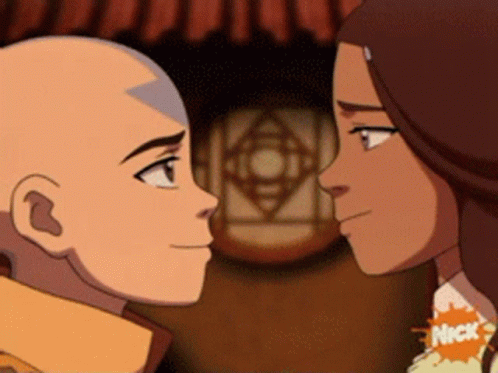
Kataang's appeal to women is reflected in how Katara is almost always the one to initiate physical affection with Aang. With only 3 exceptions, one of which, the Ember Island kiss being immediately shown by the narrative as wrong, and another being a daydream due to Aang's sleep deptivation. The first moment of outwardly romantic affection between Aang and Katara is her kissing his cheek. And their last kiss in the show is also initiated by Katara.
I won't falsely state that Kataang is the perfect representation of the female gaze. Not only because the storyline has its imperfections, as every piece of media has. But also because I simply belive that the concept of the female gaze is too varied and nebulous to be fully expressed. With this essay, I simply wanted to prove that Kataang is most certainly not the embodiment of catering to the male gaze either. In fact it is quite far from that.
The aspects of Kataang that fall more towards embodying the female gaze don't just appeal to women. There's a reason a lot of vocal Kataang shippers you find are queer. The mutual emotional connection between Katara and Aang is something we don't have to identify with, but something we are still able to emphasise with. It's a profound mutual connection that we watch unfold from both perspectives that sort of tracends more physical, gendered aspects of many onscreen romances. You just need to see instead of simply look.
✨️Bonus round✨️
Aang under the gaze
This started off as a simple part of the previous essay, however I decided I wanted to give it it's own focus, due to the whole discourse around Aang being a wish-fullfilling self insert for Bryke or for men in genral. I always found this baffling considering how utterly... unappealing Aang is to the male gaze.
It may surprise some of you that men are also subjected to the male gaze. Now sadly, this has nothing to do with the male gaze of the male gays. No, when male characters, usually the male protagonist, are created to cater to the male gaze, they aren't portrayed as sexually desirable passive objects, but they embody the active/masculine aide of the binary Laura Mulvey spoke of in the quote I shared at the beginning of this essay.
The protagonist under the male gaze is not the object of desire but rather a character men and boys would desire to be.
They're usually the pinnacle of traditional, stereotypical masculinity.
Appearance wise: muscular but too broad, chiseled facial features, smouldering eyes, depending on the genre wearing something classy or some manner of armour.
Personalitywise they may vary from the cool, suave James Bond type, or a more hotblooded forceful "Alpha male" type. However these are minor differences in the grand scheme of things. The basis is that this protagonist embodies some manner of idealised man. He's strong, decisive, domineering, in control, intimidating... you get the gist. Watch nearly any action movie. There's also a strong focus placed on having sway or power over others. Often men for the male gaze are presented as wealthy, having power and status. Studies (that were proved to be flawed in the way the data was gathered, I believe) say that womem value resources in potential male partners, so it's not surprising that the ideal man has something many believe would attract "mates". [Ew I hated saying that].
Alright, now let's see how Aang holds up to these standards.

Well... um...
Aang does have power, he is the Avatar. However, he is often actually ignored, blown off and otherwise dismissed, either due to his age or his personality and ideals being seen as unrealistic and foolish. Additionally, Aang, as a member of a culture lost a century ago, is also often posited as an outsider, singled out as weak, his beliefs touted as the reason his people died out and.
Physically, Aang doesn't look like the male protagonist archetype, either. He isn't your average late teens to brushing up against middle aged. Aang is very much a child and this is reflected in his soft round features, large eyes and short, less built body. This is not a build most men would aspire to. Now, he still has incredible physical prowess, due to his bending. But I'm not sure how many men are desperate to achieve the "pacifist 12 year old" build to attract women.
Hailing from a nation that had quite an egalitarian system, Aang wouldn't have conventional ideas surrounding leadership, even if he does step up into it later. He also has little in the way of possessions, by choice.
As for Aang's personality, well...

I mean I wouldn't exactly call him your average James Bond or superhero. Aang is mainly characterised through his kindness, empathy, cheerful nature and occasional childishness (which slowly is drained as the trauma intesifies. yay.)
Aang is very unwilling to initiate violence, which sets him aside from many other male protagonists of his era, who were champing at the bit to kick some ass. He values nature, art, dance and fun. He's in tune with his emotions. He tries to desecalate situations before he starts a fight.
Some would say many of Aang's qualities could be classified as feminine. While the other main male characters, Zuko and Sokka try to embody their respective concepts of the ideal man (tied to their fathers), Aang seems content with how he presents and acts. He feels no need to perform masculinity as many men do, choosing to be true to his emotions and feelings.
These "feminine" qualities often attract ridicule from other within the show. He is emasculated or infantiliased as a form of mockery multiple times, the most notable examples being the Ember Island play and Ozai tauntingly referring to him as a "little boy". Hell, even certain Aang haters have participated in this, for example saying that he looks like a bald lesbian.
I'd even argue that, in his relationships with other characters, Aang often represents the passive/feminine. Especially towards Zuko, Aang takes on an almost objectified role of a trophy that can be used to purchase Ozai's love. [Zuko's dehumanisation of others needs to be discussed later, but it isn't surprising with how he was raised and a huge part of his arc is steerring away from that way of thinking.]
Aang and Zuko almost embody certain streotypes about relationships, the forceful, more masculine being a literal pursuer, and the gentler, more feminine being pusued.
We often see Aang framed from Zuko's perspective, creating something akin to the mutual gaze of Katara and Aang, hinting at the potential of Zuko and Aang becoming friends, a concept that is then voiced explicitly in The Blue Spirit.
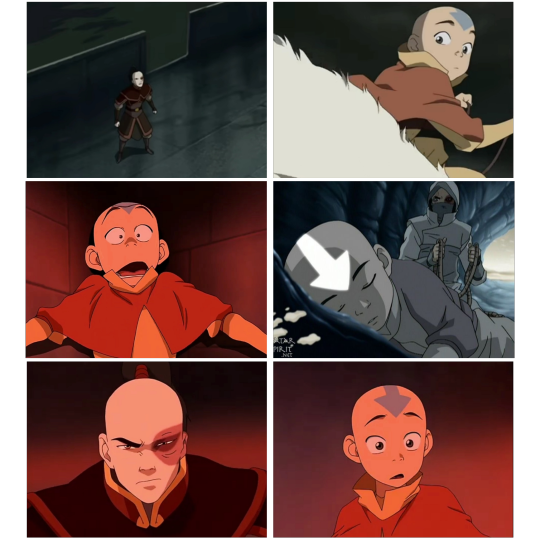
However, unlike Katara, Zuko is unable to empathise with Aang at first, still seeing Aang as more of an object than a person. We have here an interesting imbalance of Aang seeing Zuko but Zuko meerly looking at Aang.
There is a certain aspect of queer metaphor to Zuko's pursuit of Aang, but I fear I've gotten off topic.
Wrapping this long essay up, I want to reiterate that I'm not saying that Zutara isn't popular with women. Most Zutara shippers I've encountered are women. And most Kataang shippers I've encountered are... also women. Because fandom spaces are occupied predominantly by women.
I'm not exactly making a moral judgement on any shippers either, or to point at Kataang and go: "oh, look girls can like this too. Stop shipping Zutara and come ship this instead."
I want to point out that the juxtaposition of Zutara and Kataang as respectively appealing to the feminine and masculine, is a flawed endeavour because neither ship does this fully.
The concept of Kataang being a purely male fantasy is also flawed due to the points I've outlied in this post.
Are there going to be male Kataang shippers who self insert onto Aang and use it for wish fulfilment? Probably. Are there going to be male Zutara shippers who do the same? Also probably.
In the end, our interpretation of media, particularly visual mediums like film are heavily influenced by our own biases, interests, beliefs andmost importantly our... well, our gaze. The creators can try to steer us with meaningful shots and voiced thought, directing actors or animating a scene to be a certain way, but ultimately we all inevitably draw our own conclusions.
A fan of Zutara can argue that Kataang is the epitome of catering to the male gaze, while Zutara is the answer to women everywhere's wishes.
While I can just as easily argue the exact opposite.
It really is just a matter of interpretation. What is really interesting, is what our gaze says about us. What we can see of ourselves when the subject gazes back at us.
I may want to analyse how Zutara caters to the male gaze in some instances, if those of you who manage to slog through this essay enjoy the subject matter.
#ok getting off my soapbox#i forgot how much i love to write these long sprawling essays...#kataang#pro kataang#aang#pro aang#aanglove#aang defense squad#pro katara#katara defense squad#kataang love#zuko#avatar#atla#avatar: the last airbender#the last airbender#avatar the last airbender#aang the last airbender#anti zutara
411 notes
·
View notes
Text
Rohini & Ashlesha ruling over, "The Siren Archetype"
Siren means a seductively beautiful or irresistible woman, especially one who beguiles men with a alluring voice but is also very dangerous.



I observed for the past few months of female celebrities who are considered to be "Sirens" and the two nakshatras that arose the highest in a lot of these women big 3, big 6, atmakaraka, lagnesh, or ascendant lord were Rohini and Ashlesha! In my opinion it 100% makes sense because Rohini and Ashlesha are known to be the most seductive nakshatras.
Rohini is naturally a seductive and alluring nakshatra, they have a huge amount of magnetism and irresistibility. Many perceive them to be docile and innocent which is a little true but at the same time Rohini individuals have a beguiling dark side and it's shown through fashion, makeup, and mannerisms. Their hypnotic snake-like eyes and allure will lure you in like a moth to a flame.
Ashlesha possess an tantalizing and enticing quality that's hard resist with a lot of people deeming them as incredibly sexy beauties. Their aura and the way they talk is very tempting almost attracting everyone towards them in just one minute. They already are rule the dark feminine aesthetic and the Siren eyed look, the gaze is hypnotizing and captivating. Ashlesha women are extremely powerful seductress.
Another thing that Rohini and Ashlesha have in common is the power attraction able to pull masses with ease due to their enthralling and entrancing talents and they're both connected to snakes which grants them seduction and hypnotism, but also snakes has connections to water too some snakes know how to swim and those that are born with snake yoni nakshatras can be excellent swimmers and sensual dancers. Snake nakshatras make great singers, they have breathy, sultry, and trance-inducing vocals. Both of these nakshatras tend to attract people that want to abuse, and take advantage of them because of their beauty, charm, and seductiveness. It's similar to a snake it'll be minding its own business just passing through and then all of a sudden humans or animals will catch hold of the its presence admiring it or immediately freaking out wanting to attack it, this is why snakes are constantly on defense mode from things and people that'll want to harm them much similar to Siren and her singing. Thanks to the venom that snakes maintain that is too used to protect themselves as well.
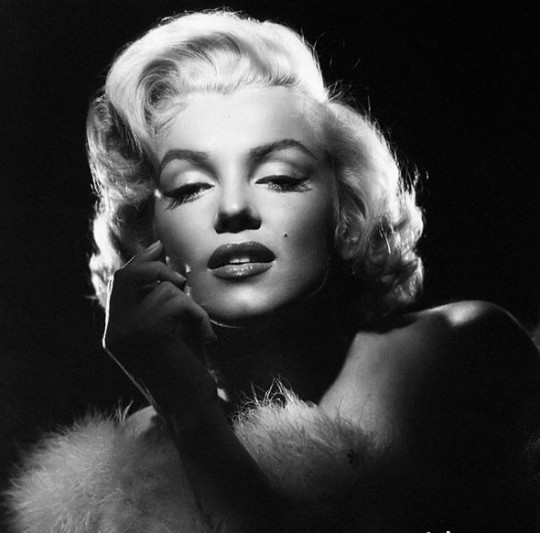
Marilyn Monroe 🖤 Rohini Sun & Mercury, Ashlesha Ascendant
Marilyn was known to be one of the most popular and beloved sex symbol in her prime and still is after her death. She's also referred to being the most iconic Siren, Marilyn had a magnetic charisma about her that many viewers, and fans, loved about her. She was enormously irresistible to masses with her beautiful appearance, blonde hair, red lips, and hourglass figure was a big part of her allure. Why do you think those who use the 'Marilyn Monroe Effect' to exude confidence, sensuality, and timeless beauty that she personified. Marilyn Monroe was a force to be wrecked with and still is!



Salma Hayek 🖤 Ashlesha Venus Atmakaraka
The seductive Salma Hayek, forever an enchantress has remained a beacon of raw sensuality and untamed beauty for many decades, with her dark eyes, thick raven tresses, and hourglass figure. Her spellbinding allure is undoubtedly unmatched, in 1996's Dusk Till Dawn most iconic scene Salma gained massive attention worldwide for her exotic and complling snake dance in the movie, you'll think she was a siren out of water performing that dance.


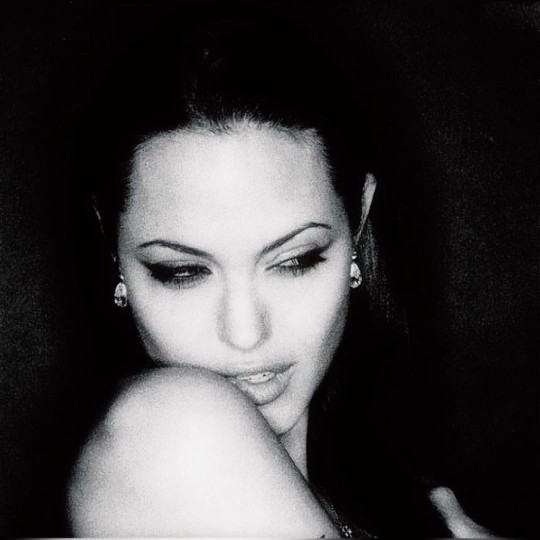
Angelina Jolie 🖤 Rohini Sun
Halting as the world's most beautiful woman to ever hit this world is also a famous Siren which you can see through her movies, interviews, and photos. Angelina has this siren-like and hypnotic gaze able to captivate those that look into her eyes, her entire existence is the reason why she subconsciously causes extreme reactions within the public. Angelina has a erotic and tempting quality to her that's a big factor to her appeal, beauty, and aura she's everybody's girl crush of the century. Angelina Jolie will forever be that girl!



Alexa Demie 🖤 Ashlesha Jupiter & Ascendant
Alexa known to play Maddy Perez in Euphoria, because of her role in Euphoria she gained a mass following on social media. Alexa is also a private person barely revealing things about herself and personal life which led to people being intrigued by her, she has a enigmatic and mystifying trait about her that no one can explain not even me. Alexa doesn't have to try anything to grab anyone's attention her ravishing beauty and the way she carries herself quickly captures onlookers eyes, to me Alexa Demie embodies the true traits of a Siren.


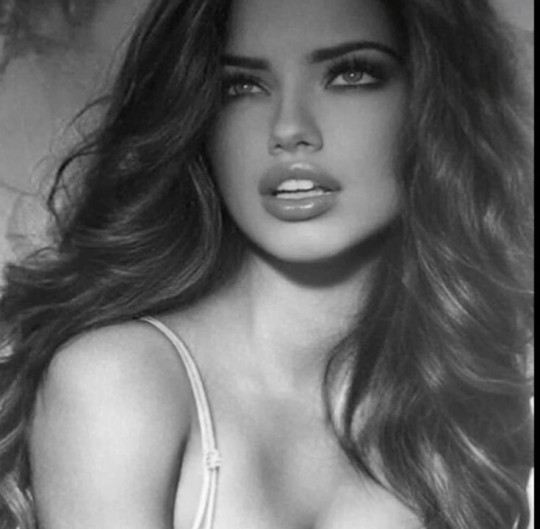
Adriana Lima 🖤 Ascendant Lord Mars in Rohini
Adriana is one of the most famous and successful models to ever walk multiple runways, in 2012 she's even been viewed by more than 100 million people from her appearing in two Super Bowl ads in one game! Ever since then Adriana still remained one of the most popular Victoria's Secret models, in 2012 Adriana is ranked 4th on the list of top-earning models with an estimated annual salary of $7.3 million and in 2021 she ranked 2nd with an estimated salary of $30 million. Adriana is noted for her magnetic presence and remaining agelessly alluring, she's effortlessly oozing charm and confidence through her walks, becoming a known figure of beauty and in the modeling world.



Ailyn 🖤 Rohini Sun & Mercury, Possible Ashlesha Moon
Before I finish up this post I'd like to add Ailyn here, she was a former singer in the Norwegian metal band called, "Sirenia" and when she was still in the group they had a album named, "Perils of the Deep Blue" that came out in 2013 with the cover image of Siren. All of the songs in the album is dedicated to Siren, Ailyn's singing and essence alone is reminding me of a Siren.


More Siren Examples
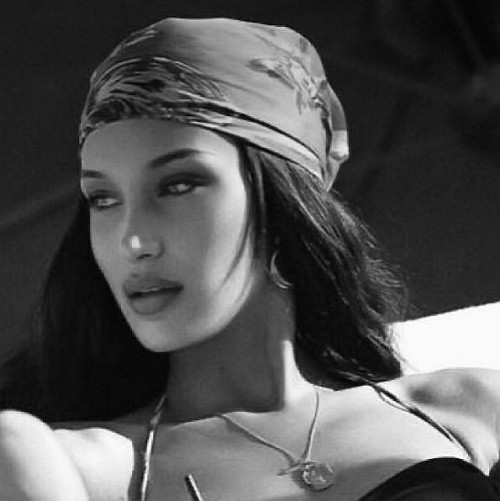
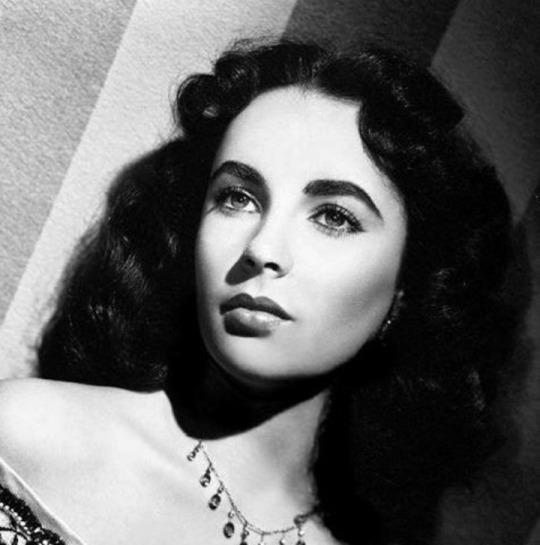

Brigitte Bardot [Rohini Moon and Ashlesha Mars], Bella Hadid [Ashlesha Mars Atmakaraka], Michelle Pfeiffer [Rohini Ascendant], Halle Berry [Ashlesha Sun], Emily Ratajkowski [Rohini Sun], Mila Kunis [Ashlesha Sun], Madison Beer [Rohini Ascendant], Monica Bellucci [Ashlesha Venus], Hwasa [Rohini Moon], Mae West [Ashlesha Mercury], Gabbriette Betchel [Rohini Moon], Elizabeth Taylor [Ashlesha Jupiter], Uma Thurman [Rohini Mars], Jennifer Lawrence [Ashlesha Sun], Olivia Wilde [Rohini Moon], Charlize Theron [Ashlesha Sun, Moon, & Mercury]
#vedic astrology#vedic astro notes#ashlesha nakshatra#nakshatras#vedic astro observations#rohini nakshatra#siren#the siren archetype#rohini#ashlesha
309 notes
·
View notes
Text
Nana Komatsu, the fear of loneliness, and the perfect tragedy of her story
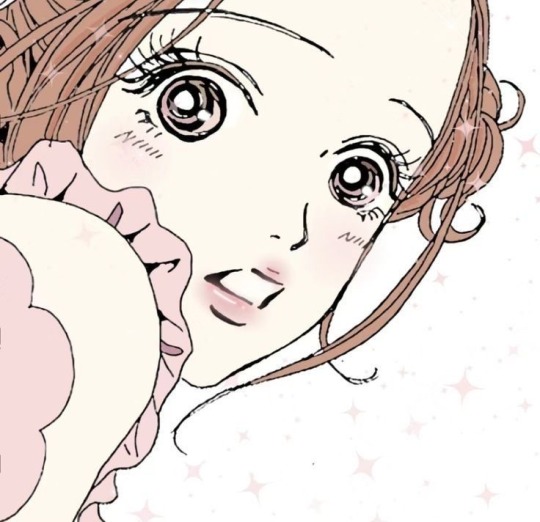
Within the Nana fandom, it is a widely acknowledged fact that Nana Komatsu ( who I will be calling Hachi for convenience) is written and portrayed as a clingy and needy character. Naturally, the effect that such a personality has on the viewers varies, with some enjoying and even empathising with Hachi, while others feel less inclined to such character archetypes, or even real life people, for a plethora of different reasons.
However, I believe that while this aspect of her personality is often highlighted, it plays a much deeper narrative role than it is given credit for. What may initially have seemed like a benign and overused personality trait — Hachi’s need for connection — actually plays a much larger role in shaping the course of her life, and understanding her relationship with loneliness and attachment allows for a greater understanding of her decisions within the anime and manga ( understanding not justification)
To do this we must examine how Ai Yazawa chooses to present Hachi to us, the viewers, in the first few episodes / chapters, and why. Hachi from the get go is depicted to be boy crazy - a girl with her head in the clouds. Someone who is quick to endear herself to others, and even quicker to idolise them - she is a character that wholeheartedly indulges in and thrives off love and attention, even if it is at the expense of her own wishes and dignity (will elaborate). We follow Hachi through her intense attachments - from her art teacher, to the pizza delivery boy, to the guy in the shop, to Asano. Out of all these attachments, we think we can see a recurring theme - they are all of romantic nature, and showcase Hachis constant search and desire to be loved. And yet there is a character whose interactions with Hachi are even more telling of Hachi’s priorities, and which I think is often undermined in the fandom due to the focus of Hachi's romantic pursuits, yet crucial to the foreshadowing and understanding of Hachi’s character and story.
Junko. We see a bond established between them right at the beginning of the anime/manga, while we're still getting to know Hachi, which serves as a key foundation for her characterisation. Hachi follows Junko to art school simply because Junko went. We observe as Hachi interacts with Junko, seeking advice,comfort and security from her, while also allowing herself to be condescended and even embarrassed by Junko. An example of this is when Junko tells Shoji and kyosuke as soon as Hachi meets them that she is loud and has a long history with men. While these traits aren't inherently negative, in the context of the society and time the manga is set in, they were not viewed as favourable traits for women. Hachi's initial protests at having these aspects of her life exposed are telling. Junko can tend at times at the start of the story to be very brisk and sometimes even outright insensitive to Hachi. Yet, when Junko decides to go to Tokyo, Hachi tearfully begs her to stay, even diminishing Kyosuke's importance to his face in an effort to keep Junko close. Realising it would be unfair to hold Junko back from her dreams, Hachi impulsively decides to apply to schools in Tokyo as well. She had no money, no set career aspirations, and no solid plans, yet was adamant to join her friend.
And this brings us to the key aspect of Hachi’s character that Ai Yazawa informed us of from very early on: she will uproot her whole life in order to not be alone. And this trait is depicted throughout all her relationships, platonic and romantic. Hachi may be boy obsessed, but to diminish her later actions to just that is a disservice to Ai Yazawa’s writing skills, as in these pivotal few scenes, Hachi’s past and future link and meld together immaculately - Hachi’s decision to stay with Takumi was foreshadowed and hinted at phenomenally from the very start of the story through Hachi’s past, and how it shaped her interactions with other characters. Her actions were rooted more in a desperate need for companionship and fear for loneliness than, as some people believe, a habit of putting her romantic relationships on a pedestal - and Ai Yazawa has reminded us of this throughout the story.
Hachi grew up in a loud and rather indifferent household where she grew up ( as a middle child) thinking that her absence would just mean less noise in the household, a thought probably encouraged by her parents' passive and impartial approach to parenting and her growing up, giving her an excess of freedom instead of the attention Hachi desired growing up. Given such an environment, she developed an anxious attachment style, clinging onto whatever relationships she has in order to avoid feeling lonely and isolated, such as her friendship with Junko. She compares the feeling to be worse than Asano breaking up with her - the moment when she realised the extent of her unrequited love and the fragility of relationships, causing her to come to terms fully with the threat of loneliness and abandonment. This concept and revelation seems to haunt her visibly throughout the first few episodes, and more insipidly years later as she still seeks companionship and intimacy to avoid the depression and fear she feels when encountering the emotion that she has correlated with feeling unwanted and used.
So given this, it makes Hachis decision to stay with Takumi even more painstakingly in line with her character. Hachi is not written to be a perfect character for readers to project their own morals into - Hachi is young, still rather sheltered and unsure of her place in the world. She thrives off others' reassurance and the security they provide her - when she feels this is being threatened ( such as when she saw Nana interact with Tsuzuki) she spirals. So when she found out she was pregnant, Takumi very intentionally divulged the information without giving Hachi a chance to prepare, recognising Hachi’s intense aversion to being alone, and exploited it in the scenario to fit his interests in keeping her by his side. Hachi was at this part of the story in a very vulnerable and insecure position. She feared and expected rejection and disappointment from her friends, a reflection of her own and society's negative and sexist feelings on her situation, and saw herself as alone. Blast was excelling and becoming increasingly busy, Junko and Kyosuke were occupied in their own daily lives, and she saw herself with nobody to turn to for help or support, and was too ashamed to ask for it from people she held in such high regard. She believed she had nobody who could give her the stability and comfort she has sought for consistently throughout the manga/anime in her friends and romantic partners.
Nobody but Takumi. Hachi knew she would not be happy. She knew that she did not love him and was not loved the way she always idealised. She knew that by marrying Takumi and raising the child with him she would be sacrificing her friends’ trust and opinions of her, and putting herself in a situation that may seem like what she always wanted ( financial stability and a family) , but was less than ideal in reality. But she ended up marrying Takumi - because she believed Takumi at the time was the only one who would accept her, who would not be any more angry and disappointed at her than she was with herself. She saw him as the only option that guaranteed the security she yearned for and seeked in every one of her personal relationships, even at the expense of her own happiness and friendships - and this because we are shown time and time again that Hachi would rather uproot her life than be on her own. She would rather suffer a person and learn to love them than be without. And that is the painstaking tragedy of it all - it makes sense for her character.
Ai Yazawa does a beautiful job at showing the very human side of personalities and relationships. Personal growth is not a linear process, and while Hachi shows moments of self-awareness and even growth, with instances where she is shown slowly blossoming into a more independent woman and recognising her self-destructive tendencies, she ultimately gravitates towards what is most familiar to her. She acts seemingly as a survival instinct, where the pale mockery of a loving relationship seems more plausible and tolerable to her than the shaky and unpredictability of her future, and facing the shock and hurt of those who she holds so dear to her heart. Though this may frustrate viewers, it is also what makes Hachi such a compelling and relatable character — her choices, while flawed, feel deeply human. Hachi doesn’t always make the smart decision, nor the one best in the long run. She is a character that displays the more uncomfortable sides of human nature and actions, and is a character that can be simultaneously loved and sighed at and learnt from, which is infinitely more educational and enjoyable than a character who has things just happen to them. She is a culmination of her past experiences and how she operated through them and processed them is translated and depicted through her relationships and actions in a realistic, though heart wrenching fashion.
#nana#nana osaki#nana komatsu#nana anime#nana and hachi#takumi#ren honjo#anime and manga#anime#anime analysis#analysis#character analysis#manga#shojo anime#shojo#nana manga#show analysis#anime gif#manga nana#manga analysis#media literacy#romance anime#nobu nana#yasu nana#reira nana#nana fanart#ai yazawa#nana hachi#hachi#hachiko
257 notes
·
View notes
Text
"A Nightmare at Green Lake" is a Queer Coming-Out Story
[This essay has a PDF version; the images are crisper there]
I'm probably nine months late to this particular party, but I just finished the excellent Reverse: 1999 event "A Nightmare at Green Lake" and wanted to make a case for reading it as a story about coming out, focusing on Blonney and her repressed sexuality. It's a love letter to horror films, and a love letter to girls that love girls. Crucially, it is more the latter than the former; Green Lake is a coming-out story that uses the horror film trappings as a storytelling device, not a hard and fast rule. Spoilers for the entire event.
(All my screenshots are taken from this video, which does a wonderful job capturing the entire event.)
The inciting incident in Green Lake began years before. Jennifer visits the camp regularly as a child, writing horror stories in her diary and reading them to Jessica, who loves them. Then, Jennifer suddenly has to move away, and thus, the Incident takes place.
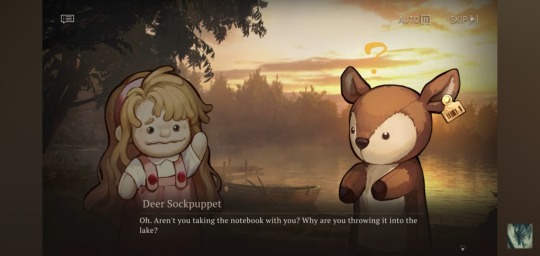
Blonney/Jennifer threw her diary into the lake when she was forced to leave, drowning three things:
1). Her horror stories and love of horror
2). Her acceptance of her identity as an Arcanist
3). Her gay-ass self
She joins human society despite being Different and tries to blend in. She changes her name to Blonney, feigns an interest in fashion, and conforms to social norms. "Monstrous and forbidden" becomes a theme in this event which describes horror, but it also describes queer identity (this will be important later). Blonney discards her identity, drowning it in the lake.
Now allow me the rest of this rambling essay to make a point for that third thing (and to make the case that "loving horror" and "being an Arcanist" is the same thing as "being gay"). Throughout the first half of the event, we see Blonney consistently reject her love of horror movies. She calls them cliche and stupid, easy to make and low-class. Despite secretly loving them, she's built up a persona that isn't allowed to like horror.

Yet she takes an awful lot of offense to criticism of her script. . .
Anne, a recent hire to replace a sick member of Blonney's film crew (who is secretly Jessica in disguise), is mistreated by Blonney for being a naive, small-town country bumpkin that doesn't know anything. Within the movie that Blonney is shooting, Anne is typecast as the "Virgin": Christian, unassuming, sheltered, in contrast to Blonney's "Blondie": indulgent, vain, etc.

Oops, are the characters in the fake movie they're shooting maybe perhaps based on their real-world counterparts???
A contrast is drawn between the two by Blonney and the narrative at first. Throughout the rest of the event, the distance between them and their character archetypes will crumble. The important thing to remember is that Anne/Jessica is a representation of everything Blonney has rejected about herself.
As actual horror-movie type events begin to happen to the group, the characters are genre-savvy enough to realize they're in a horror story. The culprit, though this isn't revealed until later, is Anne/Jessica. She's an Arcanist and has been using her shapeshifting abilities to make a horror movie happen to the group. Ironically, the group looks to Anne as the "Last Girl", the pure and unsullied one that will survive the night.

In actuality, this is a false flag. Since Anne is Jessica is the Monster, she can't be the Last Girl.
The Last Girl is actually Blonney:
I spoiled it already, but the viewer doesn't learn until the halfway point that Blonney is actually from the area, having grown up and making frequent visits. This is why she sees herself in Anne, a gay girl from a small town. Game recognize game, gay recognize gay. Blonney uses a fake name for a fake identity. Jessica sees her actual self, and calls her Jennifer. This isn't a deadnaming, Anne/Jessica sees Blonney as she truly is deep down. Though Blonney doesn't realize it, Anne cuts her to her core, which directly leads to her mistreatment.

Anne's peculiar interactions with Blonney are some of the first hints we get of the true narrative: Why is Anne so nice to her, despite the way she's treated? And more importantly, how would Anne, a newcomer to Blonney's film crew, know Blonney's real name/true identity? Blonney certainly never would've told her, she rejects her own identity, after all. This is a big nod to the true workings of the plot. Anne knows more than what she lets on. Why does Blonney not realize that Anne knows more than she should? Because Blonney is actively trying to reject that part of her—she's blind to it. If she were to acknowledge that Anne knows her true self, then the story would already be over.

On top of rejecting her love of horror, Blonney also rejects her identity as an Arcanist. This identity alienates her from her friends—they consider her a peer up until the horror story begins happening to them. The very second it is no longer convenient, they reject her as one of them and other her. The only member of her original film crew that doesn't reject her for being an Arcanist is, you guessed it, Anne.

However much you despise us, many brilliant playwrights are Queer. I mean—"Arcanists".
Horror events continue happening: a butcher chases around members of the group and monsters attack others. Vertin (R1999's main character), along with Horrorpedia, Sonetto, and Tooth Fairy, provide support, killing monsters and moving the plot along. In many of the monsters the groups find notes, pieces of paper that begin to tell a story—stories within the story. Using their knowledge of horror tropes, the main characters stay alive while Blonney's human film crew seemingly perishes at the hands of the various monster assailants.
After one such attack, Tooth Fairy (an Arcanist), gives first aid to Blonney. During the scene the two have a small argument. Tooth Fairy refuses to use Arcanist medicine to treat Blonney, because Blonney sees herself as a human. This gives Blonney a chance at some introspection, her first time opening up during this event.

Even Blonney's blood knows the truth she's suppressed.
All this happens while Tooth Fairy treats her wounds. Interesting that they're on her inner thigh, hmmm? A MILFy doctor rendering first aid to a girl's inner thighs while explaining that she's rejecting her own identity? I'm sure there's nothing to read into here.

As the plot progresses, Anne repeatedly risks her life to save Blonney. She leaps from a car to save her from a monster, and she later kills the butcher that's been chasing them. This earns her Blonney's trust, which leads to the big, plot-turning confession. At the halfway mark, Blonney is able to sit down with Anne/Jessica and confides in her.
A gay awakening ensues: Blonney feels down about her loss of identity, wanting to reclaim her love of horror. Her facade, she explains, is just that. Blonney threw away her identity as a horror-loving Arcanist in an effort to integrate with society. This conversation takes place after a danger has just been defeated, yet is one of the emotional climaxes. Blonney begins to want to accept her true identity. Throughout, Jessica repeatedly praises Blonney, telling her how amazing and wonderful she is, all the while the two cuddle on a couch.



*Does a gay little hair flip after holding hands. "You can be rougher with me, you know."



To her horror, the rest of the group hears. They had this discussion in the same room, after all, but in contrast to Blonney's old friend group, her new friends support her wholeheartedly. Then, Tooth Fairy hands Blonney the symbol of her self-actualization: her diary, which she'd found in the attic (yes, the same diary that had been thrown into the lake!!! Blonney has now retrieved her diary, her love of horror, and her identity as an Arcanist, all the things she threw away as a child.

Blonney retrieves her diary, which represents suppressed homosexuality through multiple metaphors, and achieves self-actualization thanks to her supportive friend group and a girl with a massive crush on her. The Monstrous and Forbidden are now part of her. Now the gay things really step up.
What happens next is a direct result of Blonney coming to terms with her queerness: a woman in a wedding dress shows up and attempts to marry her.

Monstrous and Forbidden, all in one package.
The woman is a zombie (because we're working with horror tropes, yeah?) but the message couldn't be more clear. Blonney has opened up to Anne/Jessica about loving horror (being queer). Now Blonney must face what that means. Consider: the corpse bride searches for her beloved (literally another bride, this could not be more fucking clear). Who is to play bride to the corpse bride? It's Blonney! The corpse bride forces Blonney down and puts a wedding ring onto her finger. The narrative has allowed Blonney to come out—now it will test her resolve.

The corpse bride is a mixed bag of metaphors. Textually, the corpse bride is a character from the horror story written in Blonney's diary. She was killed by her husband and searches for him so she can place the wedding ring back on his finger. Metatextually, the bride represents Jessica: Blonney abandoned her, effectively "killing" her. Now the scorned bride searches for her lost love.
To sum up: Jessica=Corpse Bride:
1). She searches for her lost love every night (Jessica misses Blonney)
2). She wears a hempen collar (brides don't wear collars, but Jessica does)

Blonney rises to the challenge, she defeats the corpse bride with her newfound arcanist powers, and the group pieces together the clues that the bodies carry. Her new friends are proud of her!

Horrorpedia (annoying fuckwad that he is) nicely sums up the message: by embracing their identities, they can fight back.

All the horror story clues lead to the dead body in the water. "But wait," you say, "Green Lake doesn't feature a dead body in the water." Wrong! Blonney was dead all along, remember? The corpse is Blonney's diary! Her dead body is the horror-loving gay self she killed when she threw her diary into the lake to reject her identity!
More plot happens; the story reaches a climax with Blonney using her magic to aid the group's escape from a lighthouse. On the same shore that Blonney first told Jessica all her horror stories, the same shore she killed her identity on, they confront Jessica, now revealed as the Monster. This whole plotline is the result of Blonney rejecting her identity; now is the time to make everything right.

Jessica is proud of Blonney becoming her true self. However, she's also tired of waiting for her. She's tired of being alone. Jessica offers Blonney a life of bliss: a soft bed of moss for them to share, the sweetest forest fruits, and monsters to keep her company.


When Blonney refuses to live at Green Lake forever with her, it's taken as a rejection. A fight ensues—Blonney and her group win, but the emotional arc of the story has yet to resolve.

Blonney has a chance to reject her queer identity once more. She both does and doesn't. Blonney accepts the monstrous and forbidden by accepting Jessica, a literal monster, and her queerness, the Forbidden. She rejects the monstrous and forbidden by asking Jessica to come with her, to rejoin society, to hide their identities as Arcanists (queer) and live together. Jessica rejects this. She will not be closeted. (The fear she feels at being outed as an arcanist is very similar to the fear of being outed as queer in a hostile society, eh?) This of course puts Blonney under duress—how can the story end happily?

Vertin comes in with a grenade of an offer: Jessica can come stay in the St. Pavlov Institute with her and learn to coexist with people like her. She can live with people that don't see her as weird, despite being monstrous (queer), an Arcanist (queer), and a lover of horror (queer). Vertin hasn't done much up to this point outside of moving the plot along and fighting monsters; this is her time to shine, and she shines like the lesbian lodestar we know her to be. Her conversation with Jessica is tinged with language that could easily be read as romantic, but Vertin isn't here to steal anyone's girl, she's here to offer a happy ending for everyone that guarantees the goal of each party is fulfilled. Vertin's presence is what allows this story to ultimately break free from its horror trappings. Her third option is not a compromise; it is the ending we wanted.

And what an ending it is! It's happy and good in every possible way it could be. The happiness of the ending is a large part of why I call this a coming-out story primarily rather than a horror tale. A slasher film like the ones this event draws inspiration from would see Blonney (the true Final Girl) as the only survivor of her group, still running from the monster and her own self. Instead, all her friends survive, having been held captive in Jessica's den. Blonney comes into her own; she and Jessica reconcile—we get the gay end!
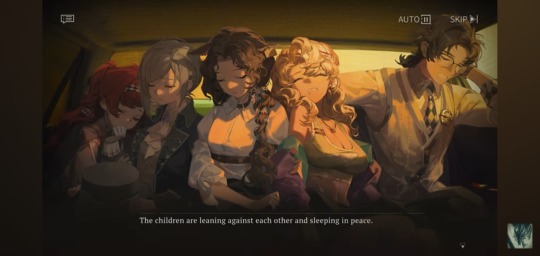
Blonney leaves to finish college as a self-actualized queer woman; Jessica acheives her wish of never being alone and joins the institute to gain an education herself. I have no doubt that they will reunite, and soon: the entire plot of R1999 is Vertin recruiting every arcanist she can to ensure their safety from the Storm. Blonney's future leads directly to St. Pavlov. (For further supporting evidence, see her voice line about taking Jessica for a walk! Even before Blonney graduates, they get to be togetherrrrrrrrrrr!)

Even if you don't play R1999, please please check out this event. It has a lot to say, and it's one of my favorite things I've read all year. The soundtrack fucking whips, and it goes far in helping balm the weeping wound of the tragic yuri that is Vertin/Schneider.
Again, give some love to the video that made this document possible.
I've rambled long enough, so I'll let Tooth Fairy wrap this up with a bow: Love Wins
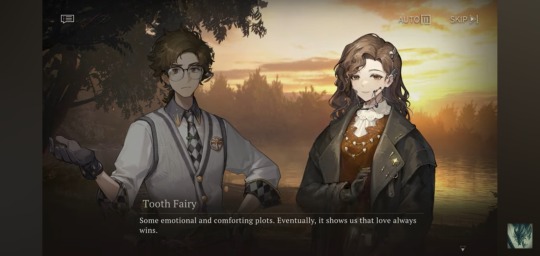
#reverse 1999#jessica reverse 1999#blonney#blossica#r1999#reverse: 1999#a nightmare at green lake#tooth fairy
149 notes
·
View notes
Note
I don't understand the arguments over the ships? Like they are all very different dynamics.
Caitvi is sweethearts turned scorned exes turned sweethearts again. Its them against the world
Jayvic is classic "i would devote my entire being to you, we will find each other in every timeline"
Timebomb is childhood friends turned enemies who never get to explore what they can be together because they are doomed by the narrative.
Very different it character archetypes too, I'm sure some people do have ill intent, but the ships and characters are so different that it doesn't make sense to accuse each other of being morally bad for preferring one over the other. Some people like happy endings, some people like the "what could have been" and others like the unshakeable devotion.
Also id like to add that part of why timebomb is so popular is because its easier for viewers to do whatever they want with it. So much about them is left up in the air, like an entire hour cut, so people have more creative control without stressing over cannon.+ They have so much unfinished business with each other that people would like to explore.
.
#timebomb#caitvi#jayvik#jayce talis#viktor arcane#vi arcane#caitlyn kiramman#ekko arcane#jinx arcane#arcane
68 notes
·
View notes
Text
Taiyang Xiao Long: The Latest in a Long Line of Fuckups
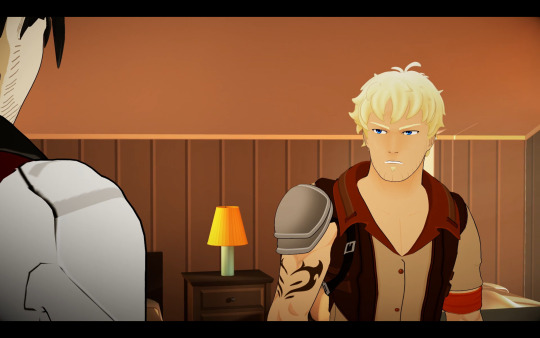
So there’s been quite a bit of discussion by this point from a number of people, myself included, about the idea that Taiyang Xiao Long isn’t actually the ‘Good Dad’ that much of the RWBY fandom has long seen him as. That he is in fact just as much of a dysfunctional fuck-up parent as Qrow, Summer, and yes, even Raven. There are a few different factors to this that others have gone into more detail on, but for me it really comes down to one core point in particular:
If you have checked out of parenting to the point where the two girls under your care can both state overtly and matter-of-factly that the older of the two raised the younger, then it frankly doesn’t matter WHAT your reasons were for checking out or how hard you may have been grieving. You have unequivocally, massively, FUCKED UP as a parent. The fact that the show has made it clear that Ruby considers Yang, her SISTER, to be her primary parent-figure does not speak well to ANY of Team STRQ’s parenting, Tai included.
However, with that said, I thought it would be worth talking about what all this discussion could actually mean in practice, ie; how might all this end up being actually explored in the story of RWBY itself?
After all, it’s not like Tai’s failings as a father have really been directly focused on or confronted or even overtly spelled out in the show thus far. The most direct we’ve gotten was during Yang’s talk with Weiss in the episode Alone Together, and even that wasn’t so much directed at Tai himself so much as describing how Yang was forced to take up so much slack in the family after Summer’s apparent death. Right now, discussion of Tai’s failings as a father is still very much ‘reading between the lines’.
And I believe that is all deliberate on the part of the writers. Thus far, the references to Tai’s failings as a parent haven’t meant to be overt and obvious to the audience. But rather they are meant to be hints and foreshadowing hiding in the margins and not immediately obvious to the viewer.
At least until it’s time to MAKE them obvious.
You see, I believe that Taiyang as a character is going to turn out to be all too similar to the likes of Qrow, Ozpin and Ironwood.
Men who are introduced appearing to represent noble and good-natured archetypes, but who wind up being revealed to have DEEP and extensive personal failings and flaws that wind up hurting themselves and all those around them. The warning signs of which turn out to have been floating around the margins, between the lines and just outside the audience’s field of view since practically their first appearances.
Consider for a moment just how characters like Ozpin, Qrow, Ironwood and Tai were/have been overtly presented in their early appearances. In other words, how the story at first wants us to view them:
The Wise Teacher
The Quirky Mentor
The Heroic Soldier
The Good Dad
And now let’s remember just how the first three wound up failing our heroines. And all of the hints we got that FORESHADOWED that failing:
All of the ‘Shady Oz’ behavior that people were noticing as early as Volume 2, and which only compiled and built over the subsequent volumes until being finally dragged into the light at the start of Volume 6.
Qrow’s rampant alcoholism, which he was outright introduced with in Volume 3 and later noted by Glynda to ALWAYS to be drunk. And shown later in Volume 5 when Ruby doesn’t bat an eye at Qrow showing up at their house near-passed out drunk.
And of course, ALL of the red flags that Ironwood was on the fast-track to fascism right from his first appearance when he showed up for the preparations of a festival celebrating peace and unity with a fleet of giant warships.
Now we have Tai, a character who turns out to have all kinds of indicators pointing to him actually being a complete dysfunctional fuck-up as a father once you start looking closely. From Yang’s multiple recountings of how Tai shut down and left HER to care for Ruby, to his shall we say QUESTIONABLE mentoring advice to Yang, to Ruby outright stating that it was YANG who raised her…
Really if you just start taking a closer look at Tai’s actions and behavior across the show, you can start finding plenty of hints and red-flags to his dysfunctional parenting hiding under a thin veneer of ‘expected’ character-archetype behavior, just like what happened with Ozpin, Qrow and Ironwood.
For example, just look at Tai’s ‘mentoring’ of Yang in Volume 4. At first glance, this scene is framed like a typical ‘hero gets tough-love advice and help from their wise and experienced parent’ situation, which is the takeaway most of us probably got on first viewing. Yet the moment you take a closer look and start unpacking what Tai is actually saying in this scene, it becomes clear, particularly in hindsight, that Tai is FULL OF SHIT. To the point of seemingly not even understanding how Yang’s semblance even works.
Or how about his claim that Raven ‘did a number of this family’, which if you actually take a minute to analyze, ESPECIALLY now in hindsight, makes no goddamn sense. How exactly can Raven have ‘done a number’ on the family when she’s been GONE from said family for the past 18 years? Particularly now that it seems like if any member is guilty of ‘doing a number’ on the STRQ, it’s actually SUMMER for going off on her super-secret suicide/martyr mission. We can’t even say that Tai can blame Raven for what happened to Summer because as Ruby’s Tree Vision made clear, Tai doesn’t even know Raven was involved. What this statement REALLY feels like is a shitload of projection and Tai blaming Raven for all of HIS fuckups as a parent.
HOWEVER, because none of this is directly framed by the show as being explicitly ‘bad’ and doesn’t present Tai with traditional/obvious ‘bad dad’ traits (see Jacques, and more on him in just a bit…) and generally couches his behavior with a veneer of ‘feeling baseline care and affection’, it’s easy to overlook on a first viewing.
Really, it feels all too much like how Volume 4 also presented Ironwood on the surface as the noble, heroic ‘only sane man’ among the authority in Atlas, all while slipping in NUMEROUS red-flags of him being on the fast track to fascism.
Speaking of Jimmy the Child Shooter, it’s been noted by a few people at this point that in hindsight, it’s pretty clear that Jacques Schnee effectively served as a red-herring villain to distract the audience from the growing red-flags surrounding Ironwood, both in Volume 4 and again in Volume 7.
Well, what if Jacques was also being used to distract the audience from TAI’s own parenting red flags in Volume 4? After all, it’s easy to be more forgiving of Tai’s sketchy parenting choices when the show keeps cutting back to Jacques’ brand of ‘parenting’.
Really, I think in hindsight Volume 4 is giving us three different looks at fatherhood: We’ve got the caring, nurturing father in Ghira, the abusive villainous father in Jacques, and the dysfunctional fuckup in Tai. A real ‘the Good, the Bad and the Ugly’ situation.
And finally, the simple fact that Yang raised Ruby. The biggest indicator of Tai’s, as well as the rest of Team STRQ’s, MASSIVE fuckups as parents which goes all the way back to Volume 1 when Gold framed Yang as a motherly figure to Ruby, outright comparing her to Summer.
It all points to Tai being set up for the same kind of big, subversive narrative rug-pull as Ozpin, Qrow and Ironwood. Men who are introduced as these strong, capable, ‘good-guy’ archetypes, only for it to be later revealed to both the heroines and the audience that these adults that they trusted are actually massive fuck-ups who have been making a mess of everything.
The only difference with Tai is that the story simply hasn’t decided to shine the light of narrative focus ON all of his numerous problems and fuckups and force our heroines to confront them like it already has with Ozpin and Qrow in Volume 6, and Ironwood in Volumes 7 and 8.
At least, not YET.
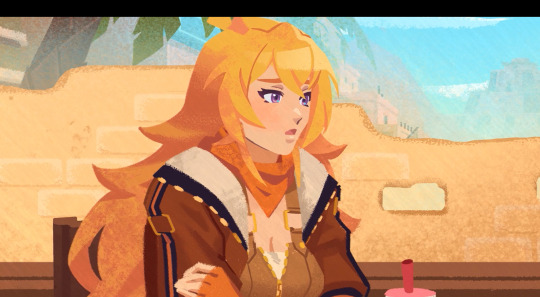
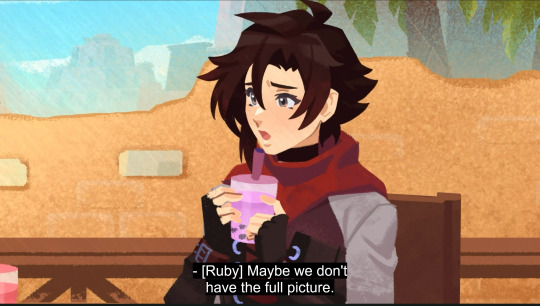
And wouldn’t you know it, the last RWBY Beyond episode set up what could be the PERFECT opportunity for that with Yang’s line about Tai being on ‘special assignment’.
Sure, people have been saying stuff like ‘Oh he’s gotta be doing something super important like guarding the Relic of Choice’, but this is RWBY we’re talking about. The show that ALREADY made a big point about how the ‘Daddy had a good reason for abandoning you’ trope is utter bullshit.
So frankly, I’d say there is NO WAY IN HELL that Tai has an actual ‘good reason’ for not having come to Vacuo to see his daughters.
And that this is instead the setup for Ruby and Yang to finally have to DEAL with all of their parents’ dysfunctional bullshit.
#rwby#rwby theory#rwby analysis#Taiyang Xiao Long#Yang Xiao Long#Ruby Rose#ozpin#Qrow Branwen#james ironwood#jacques schnee#Summer Rose#Raven Branwen#Team STRQ#tai is a dysfunctional fuckup#subverting character archetypes
84 notes
·
View notes
Note
Dean is the most iconic character on SPN because cliche bad boy and caricatures with more exaggerated personality traits tend to stand out in the mind of viewers. Sam was more subtle and nuanced.
I think you're confusing iconic with popularity. Dean Winchester's bad boy with a heart of gold trope is a popular archetype, but it's not the same as iconic. There are many popular bad boy characters, but they're not exactly memorable when it comes to storylines.
While watching a Supernatural episode, I’m more drawn to Dean because he’s more fun to watch. The next day I remember the same episode through Sam’s actions and interactions. I end up kind of forgetting what Dean did in part because he remains the same character from start to finish, both in the episode and the entire series.
So I remember Supernatural through Sam's hero journey arcs because he is a dynamic character who went from a college student naive about the supernatural world, to becoming a skilled and effective hunter and then a leader and later a father figure to a future God, and finally a father with a family of his own. Dean was essentially the same character from start to finish but that's fine for a support-protagonist, in fact it was essential for the show's formula.
Characters become iconic by; 1) being memorable when they are taken out of their time and setting and remains admirable, fascinating, or frightening regardless of time and location. Or 2) due to excellence of a trait i.e. malevolence or sweetness or determination or whatever. If you were reading a book on management theory and you saw a picture of Darth Vader, you’d have a pretty good idea what sort of manager they’re talking about.
Going by the second requirement, Dean Winchester could be an iconic character in that whenever I see a picture of him, I think of his supernatural devotion to Sam Winchester. But that's not what the Ackles Army want, and to some extent not what Jensen wants either. Just see his prequel idea.
73 notes
·
View notes
Text
I saw a tiktok comparing Paul Atreides to Daenerys and it made me want to gouge out my eyes and break my phone.

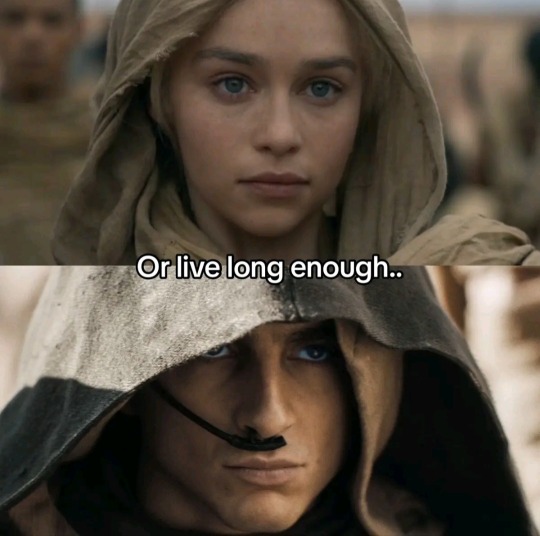
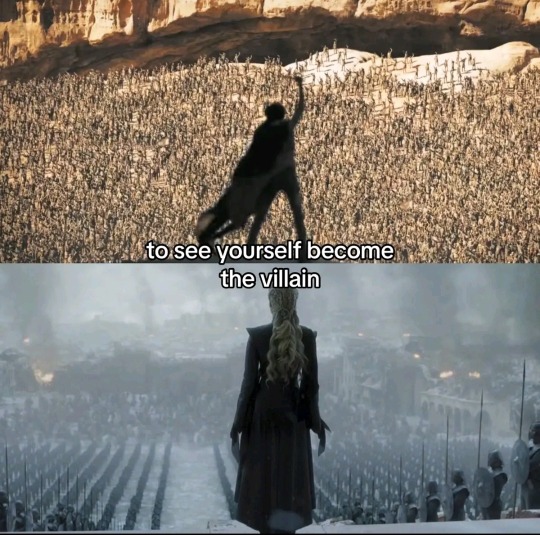
I just don't understand how Dany and Paul are comparable in any way. For one thing, Dany's ending in GOT only happened because of bad writing. There's no foreshadowing, no buildup, or reason for her fall.
Disclaimer: I haven't actually read the Dune books yet, just watched the movies and read Wikipedia stuff. So anyone who has read Dune, please please please correct me if I'm misunderstanding things.
From what I saw in the movies and read from secondhand sources, Paul was never meant to be a hero. Sure, he was a good kid, but his arc isn't that of a fallen hero. The moment Paul chose to exploit the fremen and the Bene Gesserit's false prophecy, he solidified himself as anything but a hero. He was set on vengeance and survival.
Paul is a fascinating character, but he's not a hero in any way, and wasn't at any point in his story (to my understanding).
Dany is a hero, whether you like it or not. From book/season one, she's been protecting those weaker than her to the best of her ability. She sacrifices her own desires and ambitions for the sake of others.
...this Mother of Dragons, this Breaker of Chains, is above all a rescuer. (ADWD - Tyrion VI)
Dany chooses to prioritize the innocent and the oppressed in her mission. Paul chooses to lead a holy war that will kill billions of innocents.
They're not comparable characters, because they're very different archetypes and communicate very different things from the authors. Dany is an underdog and someone who fights for justice while maintaining her gentleness. Paul is someone who basically embodies "for the greater good", sacrificing billions for the future.
Dany is written to be a hero, Paul is not. Dany is only turned from being a hero because of bad writing and sexism. Paul's descent is well written and clearly foreshadowed. Paul's story is what D&D wanted to gaslight the viewers into believing Dany's was. Unfortunately, that seems to have worked for certain parts of this fandom. Also, the poster had a Sansa pfp, so I think it's easy to tell why they view Dany this way.
Paul and Dany's characters aren't even in the same ballpark as each other. Comparing them is stupid.
#daenerys targaryen#paul atreides#anti got#anti d&d#anti sansa stans#asoiaf#dune part 2#dune spoilers#just to be safe#anti dany antis
190 notes
·
View notes
Text
Some ancient cultures have an art style of people and animals always facing sideways. But sometimes they do face forward. Rarely. So rarely. But from time to time an eye on a bit of pottery or inside of a tomb will be looking right at you. This usually means something. A character that typically looks forward, staring at the viewer. They are typically drawn that way. Their archetype is the one who breaks the fourth wall and acknowledges they are being watched, whether they be monster or god.
What are they thinking about? You, perhaps. Or nothing. They are paintings, after all. But they were created like that on purpose. Someone knew what they were doing, making them look right at you. And that’s the part that haunts me, really. The artistic intent.
210 notes
·
View notes
Text
Kahhori (from yesterday's What If? episode) genuinely feels like a Golden-Age comic book hero to me - she just punches conquistadors instead of Nazis.
Like, she's defined by her strong moral code. She inspires people in her life in a very "and you too, viewer, can also stand up to injustice in YOUR life" way. She's OP in a fun way. In an era where superhero tropes are often being subverted or addressed in meta-aware ways (to the point where "superhero film" is pretty often used as a synonym for "action film with quippy Whedon-inspired writing"), it's really cool to see a hero like Kahhori who embraces the original archetype while bringing her own culture and unique backstory to the role IMO.
Now, uh, someone please give her a comic...
249 notes
·
View notes
Text
By: Titania McGrath
Published: May 11, 2024
I was recently invited to Meghan Markle’s mansion in California for a brainstorming session on how to challenge privilege. We chatted over a light luncheon of vegan shakshuka, braised turmeric tofu and some truffle-infused seaweed that Meghan had helicoptered in that morning from Guyana.
The Sussexes do like to keep their carbon footprint to a minimum, so they only ever use one helicopter at a time.
I for one have been shocked that Meghan and Harry’s lifestyle and wellness projects have not been better received. Meghan’s Archetypes podcast with Spotify didn’t prove as successful as she’d hoped, partly because nobody seemed to be interested in what she had to say.
My feeling is that the public needs to get to know the real Meghan. People should realise what a positive influence she has been on Harry. For one thing, his toxic masculinity has all but disappeared ever since she removed his testicles for an installation art piece.
Now, the couple are planning to re-establish their brand in the UK. It turns out that Harry’s decision to write a book slagging off the Royal Family hasn’t endeared him to the British people. The masses are so fickle.
It hasn’t been easy for them. The British media is so inexplicably hostile to Meghan, just because she said they were all evil and racist. In the end, the couple were forced to flee to California to live a quiet and reclusive life. As Meghan said to those 17 million viewers on that interview with Oprah Winfrey, she just wants her privacy.
Even now, the press won’t stop writing articles about Harry. They twist everything he says to try and make him look bad. Some journalists even implied that there was something “weird” about the part of his book where he mentioned that he daubed his penis with his late mother’s favourite lip cream.
After the success of their Netflix documentary, though, Harry and Meghan are keen to branch out into making movies. I hear that they’re considering a feminist reimagining of The Godfather, or possibly an all-black remake of Schindler’s List.
#Titania McGrath#Andrew Doyle#Meghan Markle#Prince Harry#duke of sussex#duchess of sussex#parody#LOL#funny#religion is a mental illness
115 notes
·
View notes
Text



JOHN JUDE PALENCAR (b. 1957) is an American illustrator and fine artist, who specializes in works of fantasy, science fiction, and horror. In 2010, he was given the Hamilton King Award. His highly detailed work is described as containing a rich language of symbols and archetypes, which are left open to interpretation by the viewer.
(Don Bryson publication)
62 notes
·
View notes